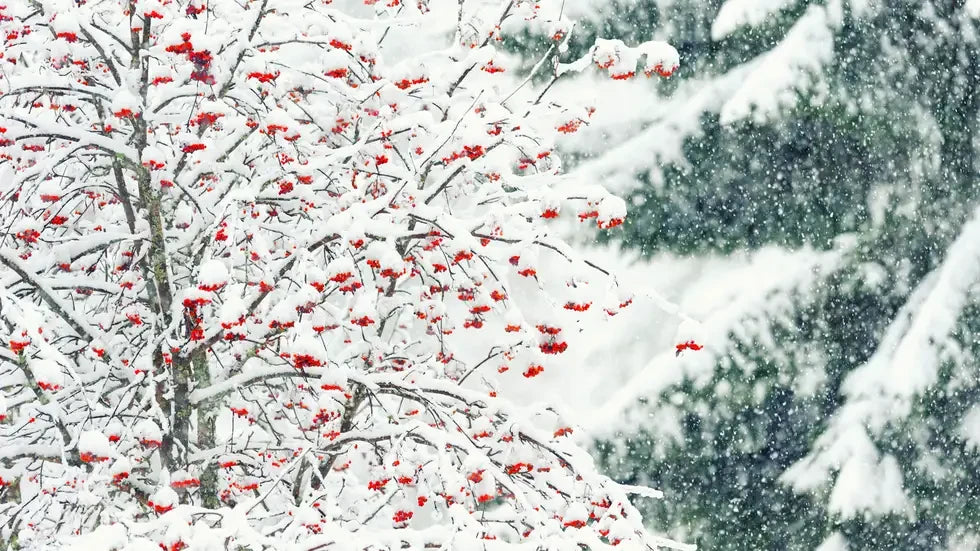The temperatures are slowly but surely dropping – winter is just around the corner. When the trees withdraw their energy, the earthworms and other soil creatures in the forest are covered with a thick, insulating layer of leaves. As temperatures drop, all biological processes - including those in the composter - slow down and it's time to reduce the amount of feed. Composting still takes place in winter, but only to a very small extent.
With your SCALE you have the following 3 options
- winter break
- Compost moderately
- Compost through the winter
winter break
Worm activity is minimal below 5°C, and if it is very cold for a long period of time, the worms will migrate down into the frost-free soil. Since it is important to avoid a build-up of undegraded waste, it is easiest to pause waste disposal during this time. In the spring, when temperatures rise again, the worms return hungry from the soil to you and their food. The worm cocoons survive even freezing temperatures. When temperatures rise in spring, the young worms hatch into the new season.
Moderate composting due to isolation and mild temperatures
One way to keep the composting going on at a lower rate is to isolate your SCALE.
Straw, leaves, sheep's wool or hemp mats are well suited as insulation. Put a thick layer of eg leaves in the composter. An accumulated layer of leaves around the SCALE can also have an insulating effect. If you have the space, be lavish because the more, the snuggier.
- Apply fresh waste only when, despite the cold weather, you can observe that the previous layer has started to decompose. To do this, push the layer of leaves aside and spread them out again after feeding, if there are any.
- During this slow composting period, take extra care not to build up a layer of waste.
- Even more important than usual: Use the whole surface of your SCALE and make sure that you only feed the amount of waste that you have enough space for to spread it thinly (3-5cm).
- If it is -10 °C or colder for a few days, the air outside becomes very dry. We therefore strongly recommend keeping an eye - or a thumb ;-) - on the moisture level of your composter and, if necessary, watering it in small quantities (with a shower attachment).

Temperature outside vs. in the SCALE above vs. below the foliage layer
 Compost outside all winter
Compost outside all winter
A trick to continue composting outside in the SCALE despite the minus temperatures in winter is to use the natural heat generated by large piles of organic waste --> exactly what we want to avoid as far as possible for the rest of the year.
This requires a few preparatory measures, but then, with a little practice, it works fantastically well.
As a reminder: Accumulated quantities of organic material naturally generate a lot of heat during decomposition. Temperatures of up to 60-70°C can be reached. Most of us are familiar with the sight of steaming piles of dung in the winter landscape, for example. Or, as here, the piles of wood shavings in beautiful Graubünden.

The nitrogen rich material in heaps creates thermophilic ie warm conditions which we want to use to keep worms & microorganisms warm over the winter and the composting process going. The resulting heat, which is generally unpleasant for the worms, serves as a heater in cold temperatures. This is only possible as long as the worms have an area to retreat to when they get too hot.
Nitrogen rich waste:
Scraps, old fruit, vegetables, coffee grounds, grass clippings, etc.
Wood chips and sawdust are suitable for an extra portion of heat. But this in a thicker layer in the composter gets pretty hot.
Create a retreat
A 20-30cm layer of finished worm castings at the bottom of the SCALE is sufficient for your worms to retreat. Additional leaves, straw or sheep's wool in and/or around the composter as insulation do not hurt. If you have only recently started using your SCALE or if you have just harvested the last crop, you can create the sanctuary using the following materials:
- Country soil or old potting soil
- mixed with shredded cardboard and/or hemp/coir fibers,
- if already available, mixed with small amounts of mature compost
- Important: This layer should have a loose, air-permeable structure and no longer be worm food.
- Add the material as a base to your SCALE below. You do this by simply pushing the material in the SCALE to the side in one area and filling the exposed area with your "litter".
Heat composting in the worm composter, the exception
So, with that in mind, you can now do what vermicomposting normally shouldn't: accumulate nitrogen-rich organic waste so it can generate heat.
- Note that this heat development needs a lot of oxygen.
- Loosening or occasional "agitation" or rearranging of these piles is important.
- This in order to always have enough oxygen to get everywhere.
- Without this loosening, you run the risk of these "piles of organic matter" tipping into anaerobic.
- Anaerobic means without oxygen - and then only the putrefactive bacteria survive, it starts to stink.
- In addition, the addition of minerals, such as those contained in our Mineral Mix, can help to ensure that this "heap" does not tip over and your composter stays in balance :-)

